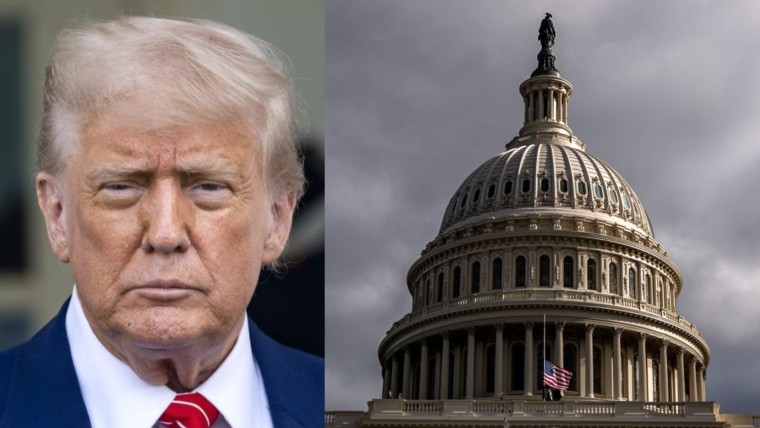UPDATE (May 19, 2025, 8:40 a.m. ET): The House Budget Committee managed to advance the GOP's reconciliation bill late Sunday night, setting up another fight as the package moves toward a full House vote.
Rep. Chip Roy of Texas had major problems with the bill his fellow Republicans presented to the House Budget Committee on Friday. On paper, the legislative package for President Donald Trump’s agenda slashes more than a trillion dollars in federal spending over the next decade. But Roy and other hard-line conservatives on the panel were frustrated at the bill’s timeline for those cuts. Their “no” votes tanked the bill and sent House leadership scrambling for last-minute weekend negotiations to salvage what Trump calls his “big, beautiful bill.”
The current bill back-loads the savings while raising the federal deficit in the short term.
Roy is right about the imbalance and trickery on display, as the current bill back-loads the savings while raising the federal deficit in the short term. The problem for him is that Speaker Mike Johnson, R-La., and the rest of the House leadership team aren’t the source of his concerns. Instead, the catalyst for his ire lies down Pennsylvania Avenue at the White House.
Trump has been impatient for Congress to pass the reconciliation bill that will fuel his agenda for the next year. As a result, the House is trying to cram all his legislative priorities into one bill. It smashes together an extension of the 2017 tax cuts — the one major legislative success of his first term — with funding for immigration enforcement and other White House priorities. That spending needs to be paid for somehow, prompting a hunt for at least $4 trillion in savings over the next decade to finance it all.
At the same time, the president and his team have been deeply reticent about an all-out assault on the social spending that has fueled the conservative movement for decades. Trump’s staff offered caution on a plan to shift the cost for the Supplemental Nutrition Assistance Program (SNAP) to the states. They’ve been similarly wary about the kinds of steep cuts to Medicaid archconservatives had been seeking. And they’ve been less enthusiastic than most congressional Republicans about any other moves that would strip Americans of health care — at least while Trump is still in office.
That hesitance from the White House can be chalked up in part to next year’s midterm elections. Politico’s Rachel Bade recently reported that Trump is already “hyper-engaged in the fight to keep the GOP’s majorities in Congress” and stave off a repeat of his first term:
He’s rolling out early endorsements in hopes of forestalling messy primary fights that could divert precious resources from the general election campaigns. He’s making recruitment calls and buttonholing other Republicans about how he can best use his political muscle. And he’s continuing to raise boatloads of money to shell out in 2026.
Trump’s midterm obsession is also hovering over Capitol Hill as GOP lawmakers try to write his sprawling domestic policy agenda into law. On issue after issue, Trump appears to sympathize with swing-district moderates — the “majority makers” whose races will decide the majority.
Trump’s focus on Congress might seem surprising given the utter disdain that his administration has shown for the legislative branch since taking office. But the president would still rather not lose control of either chamber to Democrats, preferring not to spend his last years in office fighting off investigations and the possibility of another impeachment.
And while targeting “DEI” programs and firing government workers is easily defensible to the MAGA base, potentially stripping those same GOP voters of benefits that they’ve grown accustomed to receiving would be much harder to sell.
I’d prefer Roy’s honest cruelty to the con job that Trump would much rather pull to keep Congress in Republican hands
Don’t mistake Trump’s caution for triangulation. The closest he’s come to trying to usurp Democrats’ positioning on an issue is floating hypothetical tax increases on the wealthy to undercut their attacks on his tax cuts as a very real handout for the wealthy. At most, he’s been trying to obscure the most unpopular parts of the GOP’s agenda — or at least delay their implementation.
In the process, the budget bill has been front-loaded with a ton of goodies for taxpayers, including a “MAGA account” for newborns, a $4,000 “senior bonus,” a new deduction to essentially refund taxes on overtime pay, and a moratorium on taxes on tips. But most of those provisions are written to expire in 2028, just as Trump’s term is ending.
Meanwhile, the painful bits intended to pay for all that new spending were slated to be strung out much further down the line — funnily enough, right around the time the new benefits are due to end. For example, the bill wouldn’t shift the costs of SNAP benefits to the states until fiscal year 2028. The Medicaid work requirements that Republicans are counting on to save $300 billion — at the cost of millions losing their insurance — aren’t due to begin until 2029. And as The New York Times noted, the net effect would still see the wealthiest Americans benefit the most while the poor would struggle further.
The dishonesty of claiming to cut spending while raising the deficit, only to punt the actual cuts to much further down the line, was too much for Roy and other conservatives to bear. His protest likely succeeded in at least bumping up the Medicaid work requirements at least to start much sooner. That alone would throw a wrench into Trump’s scheme to bribe voters now and flee before the pain of what he’s done really hits them. There are no heroes in this story, but I’d prefer Roy’s honest cruelty to the con job that Trump would much rather pull to keep Congress in Republican hands.

